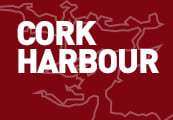#divingbell – The Minister for Transport, Tourism and Sport, Paschal Donohoe, TD, has officially opened Dublin's newest visitor attraction, Dublin Port's Diving Bell. As reported by Afloat.ie back in February, following a four month restoration project by Dublin Port Company, the striking, orange metal structure on Sir John Rogerson's Quay is an important addition to the public realm in Docklands. It will appeal to local people who have always wondered about the purpose of this odd-looking bell structure, and visitors to the city keen to learn more about Dublin as a port city.
Transformed into an interpretive exhibition, visitors can now learn in detail about the origin and history of this important artefact in Dublin's maritime history. An ingenious feat of Irish engineering, the Diving Bell was essential in building Dublin's quay walls for 87 years.

The Diving Bell was designed by the port engineer Bindon Blood Stoney (1828 to 1907) above and built by Grendon and Co., Drogheda. It was delivered to the Port in 1866, entered service in 1871 and was used in the building of the Port's quay walls until 1958. Stoney was a prodigious engineer and among his achievements were the building of the Boyne Viaduct in Drogheda, the construction of O'Connell Bridge and the building of many of the Port's quay walls including Sir John Rogerson's Quay and North Wall Quay Extension.
The Diving Bell was used in the building of the Port's quay walls from the Victorian era right up until almost the 1960's. It was a ground-breaking piece of engineering innovation in its day. Its lower section was hollow and bottomless, providing just enough room for six men to work at a time. Once lowered into position on the riverbed, the crew entered through an access funnel from the surface and compressed air was fed in from an adjacent barge. The men inside the bell worked on the river bed exposed at their feet, excavating the site where a massive concrete block would later go; all the excavated soil was stashed in trays hanging inside the bell, and brought up when the bell was lifted.
Carried out by Weslin Construction Ltd., the restoration project involved elevating the 13m tall, 90 tonne Diving Bell onto a two metre steel structure to create a ramped public access route underneath. A water feature now runs beneath the structure accompanied by a series of interpretative panels explaining the historical, social and engineering significance of the Diving Bell. The exhibition is also illuminated at night time using energy efficient LED lighting.

The project was designed with the expertise of a range of people including the architect Sean O'Laoire, the sculptor Vivienne Roche, Tom Cosgrave (professor of engineering at the University of Limerick) and the late Mary Mulvihill of Ingenious Ireland.
Eamonn O'Reilly, Chief Executive, Dublin Port Company said: "Dublin Port Company is proud to bring the Diving Bell to life for Dubliners and visitors to the city. Our restoration project pays tribute to Bindon Blood Stoney who built the deepwater quays in Dublin in the Victorian era. It also commemorates the generations of port employees who worked in the bell. It invites the city's visitors and inhabitants, new and old, to better understand Dublin as a port city with a wealth of industrial heritage to uncover. I would encourage people to visit and discover for themselves the significance of this magnificent structure. The Diving Bell is the first of a series of important industrial heritage exhibits we plan to create in the years ahead."
The Minister for Transport, Tourism and Sport, Paschal Donohoe, T.D., said: "It is fantastic to see the Diving Bell restored to its former glory for a new generation of Dubliners and visitors to discover. The Diving Bell is a wonderful addition to Dublin's array of historical attractions and I am sure it will become a new favourite on the tourist trail through the docklands area. I commend Dublin Port Company and all involved in the project to preserve and restore this fascinating artefact for the city."



























































